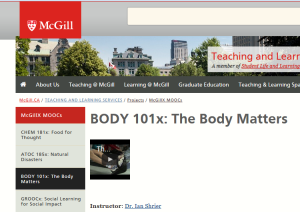
Each week students in Professor Ian Shrier’s (@McGillU) Massive Open Online Course (MOOC) ask questions. One questions is answered by our world expert panel on the BJSM blog. Here’s this week’s question.
Q: I have been working hard in gym over the last 6 months. I got cool muscles and I look very fit. I also like that instead of losing weight I gained 3 kg extra (muscles). I eat well. But what worries me is the absence of a menstrual period. I wonder if amenorrhea can be caused by just hard training (without weight loss)?
A: Answer by Professor Louise Burke, PhD & Sports Nutritionist. Australia’s multi-Olympic games sports nutritionist, lead Nutritionist at the Australian Institute of Sport and author of the definitive Clinical Sports Nutrition. Member of the IOC Consensus Statement group that described RED-S: the Relative Energy Deficiency Syndrome (read on).
Louise writes…”Being too thin or training too hard were some of the early suspects in our understanding of amenorrhea in athletes. The first version of the Female Athlete Triad syndrome added further confusion with its rigid definition of the co-existence of amenorrhea with eating disorders and osteoporosis. Over the last decade, however, an appreciation of the real dietary problem – low energy availability – has emerged. This new term helps to tie a number of issues and observations together, and provides a new perspective on why amenorrhea occurs, who is at risk, and why you should care. The answer to these questions lies in an understanding of how the body handles energy.
Energy balance just considers the difference between energy intake from food and daily energy expenditure/requirement. When daily energy intake and expenditure is roughly equal, you’re said to be in neutral energy balance (or just “energy balance”). Energy balance can be changed by changing your intake, changing your expenditure, or changing both. If this change results in an energy intake that is less than expenditure (negative energy balance), there is a general expectation that body energy stores in the form of body fat and muscle are sacrificed to bridge the deficit.
Meanwhile, energy availability focuses on energy requirements, breaking them into two components: energy for exercise and energy for health and maintenance. In an ideal world, where you want to be in top shape and top function, your energy intake would cover both components. However, if we upset this equation by reducing our energy intake, increasing the energy we commit to exercise or a mixture of both, the result is a shortfall in the energy specifically available to support other body functions. Some of these functions are critical for keeping you alive while other functions are “nice to have” but can be turned off or turned down in an emergency. This situation is termed low energy availability.
Although we’ve said that negative energy balance causes you to break down fat and muscle to contribute these energy stores to the energy deficit and try to address the low energy availability, your body is smart enough to know that this isn’t a good long-term solution. After all, you will eventually disappear if you keep sacrificing your body tissues! Your body’s solution to low energy availability is to turn down or turn off some of the less essential health and maintenance functions to save its energy costs and try to restore energy balance. The good news is that you are now more economical at being you, expending fewer Calories/kilojoules to get through the day. The bad news is that you are no longer maintaining your health and function at its top level. Loss of the menstrual cycle is one of the common casualties of the energy adjustments.
Honing back in on the MOOC question & periods stopping…
This concept raises three important findings of relevance to the current case. First, low energy availability can be associated with negative energy balance and weight loss, but not always. In some situations or some individuals, the body’s priority response to low energy availability is to adjust energy expenditure to restore energy balance at a lower energy intake. Thus, low energy availability can exist without the typical presentation of weight loss or becoming very thin.
The second update is the recognition the energy mismatch that causes low energy availability can occur in a variety of scenarios:
- Disordered eating and eating disorders
- Over-enthusiastic and/or misguided weight loss campaigns. Some athletes set unrealistic targets for weight/body fat loss; others have reasonable targets, but try to reach them way too quickly.
- A high training volume or strenuous competition schedule – particularly when this represents a sudden increase in usual patterns. It can be difficult to get a handle on just how much more energy is needed to support the new exercise program, and your appetite may be blunted by fatigue rather than directing you to eat more
- An environment in which access to food is difficult and prevents an athlete from finding food at the right time in the right amounts – tight finances, travel, boarding in residences with small windows for meal times, a hectic schedule that means always being on the run.
In other words, different types of factors can be represented in the development of low energy availability ranging from psychological problems to lack of knowledge or simply being in the wrong place at the wrong time in terms of food availability. We need to increase our recognition of the different types of athletes in which low energy availability can occur (including males!) and we need to have different solutions to fit the problem.
The third update on this syndrome belongs in the “why should you care” basket. Although amenorrhea is a common outcome of low energy availability adjustments, it is not universal (think of male athletes or post-menopausal athletes) and may not be recognised or considered problematic by some athletes. However, we now know that many other body systems are impaired by low energy availability, with casualties including poor bones and cardiovascular health, an increased risk of injury and illness, and impaired training adaptations and performance.
There are many incentives to tackle the problems of low energy availability. Indeed, many experts in sports science/medicine have identified the need to re-badge the syndrome so that it casts a wider net on the populations at risk and the problems it causes, as well as focusing attention on the underlying problem. The result is coining of the term “RED-S” (Relative Energy Deficiency in Sport) as a larger umbrella and spotlight on a common problem among athletes. RED-S promotes our new insights and provides a platform for a new approach to recognise, treat and prevent this issue.”
Links:
Listen to Dr Margo Mountjoy, MD, PhD, sports physician & MOOC lecturer – outline Relative Energy Deficiency Syndrome (RED-S) in this BJSM podcast http://ow.ly/Z5UgW
References
Mountjoy M, Sundgot-Borgen J, Burke L, Carter S, Constantini N, Lebrun C, Meyer N, Sherman R, Steffen K, Budgett R, Ljungqvist A, Ackerman K. The IOC relative energy deficiency in sport clinical assessment tool (RED-S CAT). Br J Sports Med. 2015;49(21):1354.
Mountjoy M, Sundgot-Borgen J, Burke L, Carter S, Constantini N, Lebrun C, Meyer N, Sherman R, Steffen K, Budgett R, Ljungqvist A. Authors’ 2015 additions to the IOC consensus statement: Relative Energy Deficiency in Sport(RED-S).
Br J Sports Med. 2015;49(7):417-20.
Mountjoy M, Sundgot-Borgen J, Burke L, Carter S, Constantini N, Lebrun C, Meyer N, Sherman R, Steffen K, Budgett R, Ljungqvist A. The IOC consensus statement: beyond the Female Athlete Triad–Relative Energy Deficiency inSport (RED-S). Br J Sports Med. 2014;48(7):491-7
